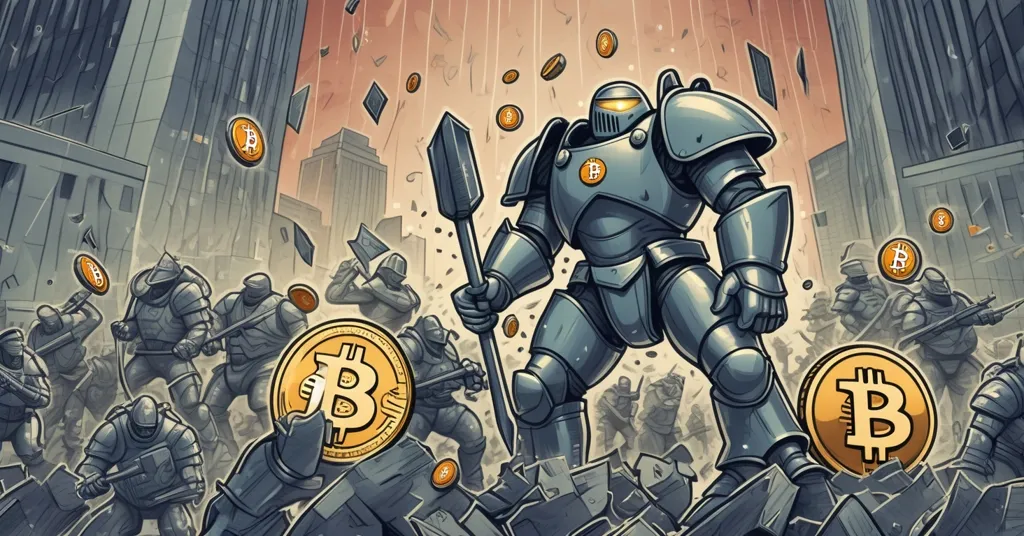Crypto Markets Brace for Volatility as Fed Decision Looms Over Bitcoin and Altcoins

Crypto Markets on Edge as Wall Street Awaits the Fed’s Next Move
Global financial markets are a powder keg right now, and the cryptocurrency sector is feeling the heat as a barrage of U.S. economic data and looming Federal Reserve decisions threaten to ignite major volatility this week. Bitcoin, the titan of digital assets, along with altcoins like Ethereum and Solana, could be in for a wild ride as macroeconomic forces and regulatory shifts collide. For deeper insights into the tension gripping the markets, check out this detailed analysis of crypto markets awaiting the Fed’s next steps.
- Data Overload: U.S. releases like PPI, PCE, and jobless claims could jolt Fed policy and crypto sentiment.
- Rate Cut Speculation: A 70% chance of a December Fed rate cut offers hope for a Bitcoin recovery post-$126,000 crash.
- Regulatory Tensions: SEC rulings on crypto ETFs and South Korea’s exchange crackdowns pile on the uncertainty.
U.S. Economic Data: A Ticking Time Bomb for Crypto
This week’s U.S. economic lineup is stacked with releases that could make or break market confidence, and crypto, as a high-risk asset class, is squarely in the crosshairs. On November 25, the Producer Price Index (PPI) drops, showing whether costs for producers are rising or cooling. Think of it as an early signal—if producers are shelling out more, consumers usually feel the pinch soon after. Then, on November 26, we get jobless claims, a quick read on unemployment trends, alongside the Personal Consumption Expenditures (PCE) Index, the Fed’s preferred measure of consumer inflation. Unlike the more well-known Consumer Price Index (CPI), PCE focuses on how households actually spend, offering a sharper lens on inflation’s real-world bite. For Bitcoin and other digital currencies, these numbers are seismic. If inflation looks tame, it could pave the way for looser Fed policy, potentially lifting risk assets like crypto. But if the data screams “hot,” expect a sell-off as fears of tighter money grip the market.
Complicating matters, U.S. markets are closed on November 27 for Thanksgiving and run on shortened hours on November 28. That’s a recipe for thin trading volumes, and in crypto’s non-stop trading world, low liquidity often means exaggerated price swings. A minor hiccup can snowball into a massacre—or a tiny spark can send prices to the moon. Fresh off Bitcoin’s brutal retreat from its all-time high above $126,000, where overleveraged traders got obliterated in a liquidation frenzy worth billions, the stakes feel even higher. Holiday silence from Wall Street could turn any reaction to these data points into a full-blown crypto drama. If you’re holding BTC or any altcoin, it’s time to keep your eyes peeled and your stop-losses tight.
Fed Rate Cuts: Lifeline or False Hope for Bitcoin?
While economic data sets the stage, the Federal Reserve holds the spotlight. The odds of a 25-basis-point rate cut in December—basically a quarter-percent drop in borrowing costs—have spiked from 30% to 70%, buoyed by hints from New York Fed President John Williams that there’s room for policy “adjustments” if the economy stumbles. For those new to this, a rate cut is like the Fed flipping a switch to make money cheaper to borrow. Investors often take that extra cash and chase bigger returns in riskier plays like Bitcoin. With BTC still nursing wounds from its $126,000 peak collapse, which wiped out leveraged positions and shook market confidence, the prospect of fresh liquidity has traders eyeing a potential rebound. Analytics firm Swissblock has noted a drop in “risk-off” signals—market lingo for panic selling—suggesting that if broader economic conditions cooperate, Bitcoin could stabilize and grind higher.
But let’s pump the brakes on the hype. Rate cuts aren’t a magic bullet. Rewind to 2022: even with Fed easing on the table, Bitcoin tanked 20% in a single week after a brutal CPI report rattled nerves. If this week’s PCE or PPI numbers hint at stubborn inflation, the Fed might hold firm or even tighten the screws, hammering risk assets like BTC and Ethereum. And while the recent sell-off cleared out some reckless leverage, crypto’s love affair with insane margin trading—think 100x bets on a whim—means another liquidation bloodbath is never far off. Here’s a devil’s advocate take: some analysts warn that even a rate cut won’t save the day if retail investors stay skittish. Liquidity is meaningless if the average Joe isn’t buying. So, while the odds look good for a cut, don’t bet the farm just yet.
Regulatory Curveballs: ETFs and Global Crackdowns
As if macro headaches weren’t enough, regulatory developments are adding fuel to the fire. In the U.S., the Securities and Exchange Commission (SEC) is poised to rule on several cryptocurrency exchange-traded funds (ETFs), including those linked to Solana and XRP. For the uninitiated, ETFs are investment products traded on traditional stock exchanges, letting big players like hedge funds and pension plans bet on crypto without directly owning it. A thumbs-up from the SEC could funnel billions into these assets, giving a massive boost to Solana, a blockchain known for lightning-fast transactions and a thriving decentralized finance (DeFi) scene, and XRP, tied to Ripple’s cross-border payment tech. Solana’s edge comes from powering countless dApps (decentralized applications) at low cost, while XRP’s value hinges partly on resolving its long-running legal battle with the SEC over whether it’s a security. Approvals could catapult prices and credibility; a rejection could crush sentiment faster than a shady ICO scam.
Across the globe, the screws are tightening too. South Korea, a crypto trading giant, is ramping up oversight through its Financial Intelligence Unit (FIU). New rules are hiking compliance costs with tougher Know Your Customer (KYC) and Anti-Money Laundering (AML) requirements, which could force smaller exchanges to fold or block everyday traders. This isn’t just a regional nuisance—South Korea often sets the tone for global trends. If other countries pile on with similar chokeholds, we’re looking at a ripple effect that could dent investor confidence worldwide. Is this the end of crypto’s lawless frontier, or just growing pains on the path to legitimacy? Hard to say, but it’s a stark reminder that crypto’s borderless nature cuts both ways—freedom to innovate, but also exposure to every government’s whims.
Bitcoin’s Staying Power in a Sea of Uncertainty
With our lean toward Bitcoin maximalism, let’s not lose sight of why BTC remains the cornerstone of this space. While Solana and XRP chase ETF-fueled hype, Bitcoin’s $1 trillion market cap and decade-plus of battle scars make it the go-to safe haven in crypto’s stormy waters. Altcoins have their place—Ethereum’s smart contracts revolutionize industries, and Solana’s speed fuels DeFi innovation—but when the macro or regulatory hammer drops, Bitcoin’s store-of-value status often holds stronger. It’s not flawless; price swings still sting, and debates over energy use persist. Yet, compared to altcoins banking on speculative catalysts, BTC’s history of rebounding—look at post-2018 or 2022 bear markets—keeps it the kingpin. If you’re navigating this mess, Bitcoin’s the anchor; everything else is a gamble.
That said, let’s not drink the Kool-Aid blindly. Bitcoin isn’t immune to macro carnage or regulatory overreach. Its dominance doesn’t mean invincibility, and if the Fed fumbles or global crackdowns escalate, even BTC could take a beating. The counterpoint here is simple: resilience isn’t a shield against systemic shocks. Still, in a world of untested altcoin promises, Bitcoin’s track record gives it an edge that’s hard to ignore.
Key Questions and Takeaways on Crypto’s High-Stakes Week
- What could U.S. economic data releases mean for cryptocurrency markets?
Releases like PPI and PCE shape Fed policy outlooks. If inflation cools, it could lift Bitcoin and other risk assets; if it’s hot, tighter policy fears might spark sell-offs. - Can a Federal Reserve rate cut trigger a Bitcoin recovery?
With a 70% chance of a December cut, cheaper money could boost risk assets like BTC, though effectiveness depends on broader investor sentiment, as history shows mixed results. - Why do SEC rulings on crypto ETFs matter for the market?
Approvals for Solana and XRP ETFs could attract institutional cash, driving prices and legitimacy, while rejections might stall momentum and sour market vibes. - How does South Korea’s regulatory crackdown impact global crypto?
Harsher rules raise costs and may limit access in a key hub, potentially shaking confidence and signaling a broader global push for stricter oversight. - Is Bitcoin the safest play amid this chaos?
Despite volatility, BTC’s massive market cap and proven resilience position it as a stronger bet than altcoins riding untested catalysts, though no asset is fully immune to systemic risks.
As this pivotal week unfolds, the clash between centralized finance and decentralized tech feels like a bare-knuckle brawl. Crypto isn’t just at the mercy of Wall Street’s moves—it’s challenging the old guard to evolve, even while grappling with their constraints. Whether we see Bitcoin claw back toward $126,000 or stumble further, the drive for financial freedom and disruption of outdated systems presses on, one chaotic price candle at a time. For traders, it’s a high-wire act; for those rooting for a new financial paradigm, it’s another skirmish in the long war. Keep your wits about you—the fight for decentralization isn’t slowing down.



